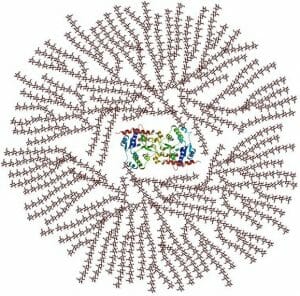Glycogenolysis Definition
Glycogenolysis is the breakdown of the molecule glycogen into glucose, a simple sugar that the body uses to produce energy. Glycogen is essentially stored energy in the form of a long chain of glucose, and glycogenolysis takes place in muscle and liver cells when more energy needs to be produced. The opposite of glycogenolysis is glycogenesis, which is the formation of glycogen from molecules of glucose.
Function of Glycogenolysis
Glycogenolysis breaks down glycogen into glucose. Specifically, the process of glycogenolysis forms one molecule of glucose-6-phosphate, leaving the remaining chain of glycogen with one less molecule of glucose. This process is repeated many times so that multiple glucose molecules can be removed from the chain. Glucose molecules are removed via phosphorolysis, which is the breaking down of a molecular bond by adding phosphoric acid.

This image shows the structure of glycogen. The center structure is the protein glycogenin, while the branches are chains of glucose. A single molecule of glycogen can contain as many as 30,000 units of glucose linked together.
Glycogenolysis occurs when levels of adenosine triphosphate (ATP), the energy molecule used in the cells, are low (and there is low glucose in the blood). Since glycogenolysis is a way of freeing up glucose, and glucose is used in the formation of ATP, it occurs when energy is low and more energy is needed. Likewise, when ATP levels are high, glycogenesis occurs instead because it is a way of storing energy.
Glycogen is stored in muscles and in the liver. It is estimated that glycogen stored in the liver makes up around 5 percent of the liver’s weight, while glycogen stored in the muscles accounts for 1-2 percent of their weight. In myocytes, which are muscle cells, glucose provides needed energy for muscle movements. Glycogenolysis in hepatocytes, or liver cells, is slightly different. When glycogenolysis occurs in the liver, the glucose that is produced is not directly used by the liver. Instead, glucose enters the bloodstream so that it can be used by other cells. Glycogen in animals is similar to starch in plants; starch is also a chain of glucose that is used for energy storage in plants and can be broken down when a plant needs energy.
Regulators of Glycogenolysis
Glycogenolysis is maintained by hormones, and in myocytes, neural signals may also play a role. Blood levels of the hormones glucagon and insulin raise and lower glucose, respectively, which affects whether or not glycogenolysis takes place. Glycogenolysis is also involved with the fight-or-flight response, which is an animal’s instinctive response to fight or flee from an opponent. In times of stress or when facing a threat, the fight-or-flight response activates and the hormone epinephrine (adrenaline) is produced. Epinephrine stimulates glycogenolysis since the body needs energy for fighting or fleeing. It also inhibits glycogenesis, since during a fight-or-flight response, the body is using energy instead of storing it. When a fight-or-flight response is not occurring (such times are sometimes referred to as “rest and digest”), glycogenesis will occur again, and glycogenolysis will be inhibited.
Enzymes Involved in Glycogenolysis
Several different enzymes are involved in glycogenolysis. Enzymes are proteins that help chemical reactions take place. One enzyme that plays a role in glycogenesis is glycogen phosphorylase. It breaks the bond linking glucose to glycogen by substituting a phosphoryl group, PO32-.
At this point, the glucose that has been detached from glycogen is glucose-1-phosphate. The enzyme phosphoglucomutase changes it into glucose-6-phosphate, which is the form that cells use to make ATP. Glycogen debranching enzyme transfers the all of the remaining glucose molecules except for one on a branch of glycogen to another branch. Last, ɑ[1→6] glucosidase removes the last glucose molecule, which gets rid of that branch of glucose molecules.
Difference Between Glycogenesis and Glycogenosis
As stated previously, glycogenesis is the opposite of glycogenolysis; it is when glycogen is formed from glucose. However, there is also glycogenosis, which has a very similar spelling but is an entirely different term. Glycogenosis, more commonly known as glycogen storage disease (GSD), is a genetic disorder in which there is a defect in the process of forming glycogen (glycogenesis) or breaking down glycogen (glycogenolysis). There are 11 different types of GSD, and approximately 1 in 20,000-25,000 people in the United States are born with a form of GSD. Some types are relatively more mild than others. GSD Type II is particularly severe, and causes death within two years of birth. Other types involve growth retardation and/or intolerance of exercise.
Related Biology Terms
- Glucose – A simple sugar that has an important role in metabolism and energy production.
- Glycogen – A molecule that has long chains of glucose; glucose is stored in the form of glycogen.
- Glycogenesis – The formation of glycogen by putting together glucose molecules; it is the opposite of glycogenolysis.
- Adenosine triphosphate (ATP) – The main molecule used for energy in cells.
Quiz
1. In which type of cells does glycogenolysis occur?
A. Myocytes
B. Hepatocytes
C. Both
D. Neither
2. What is glycogenosis?
A. The formation of glycogen from glucose
B. The formation of glucose from glycogen
C. A genetic disorder
D. The protein found in the middle of glycogen
3. The process of glycogenolysis occurs through the activity of several ______.
A. Enzymes
B. Carbohydrates
C. Lipids
D. Transcription factors
